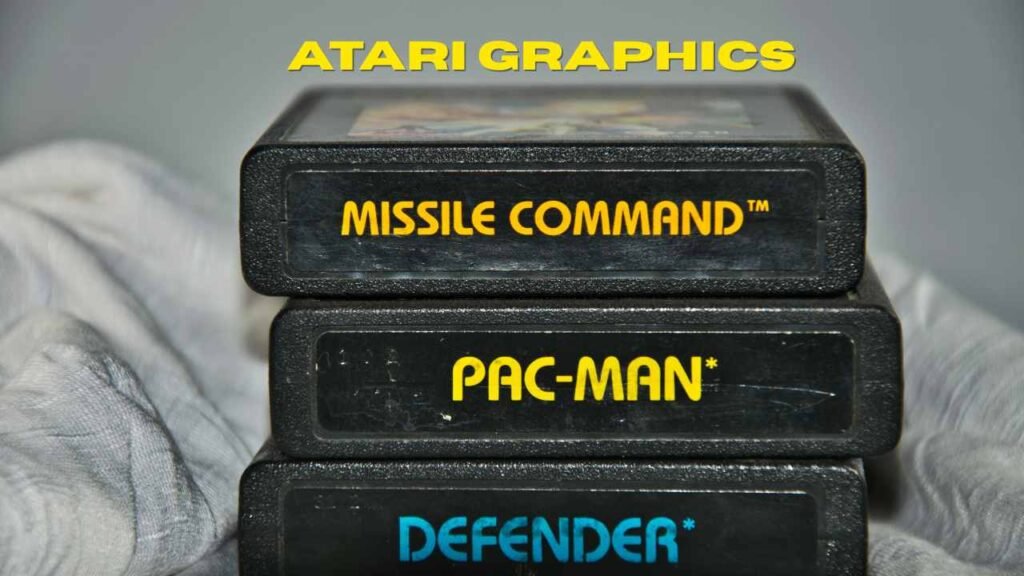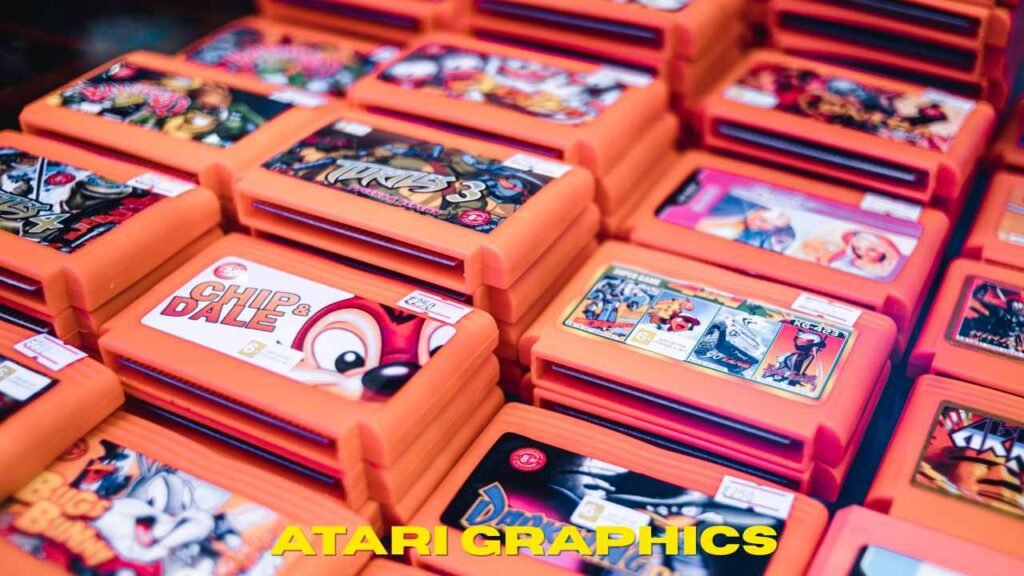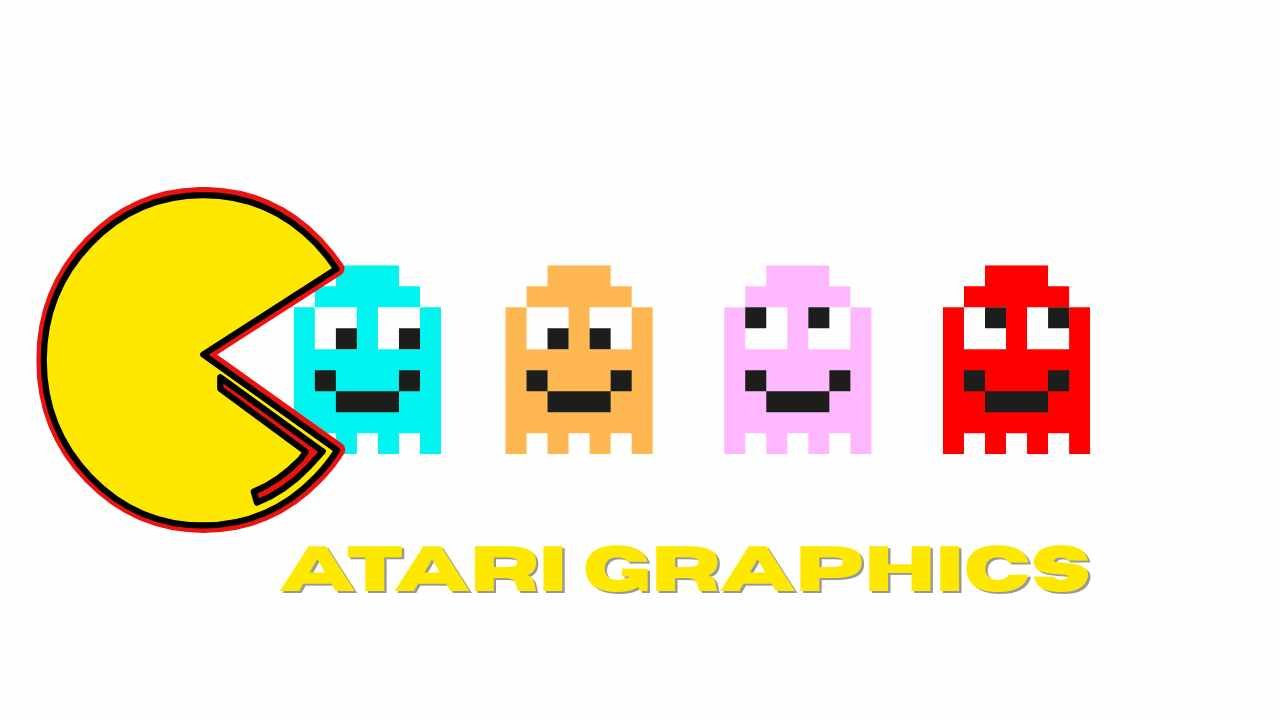Introduction: The Legacy of Atari Graphics
When we talk about the origins of video games, one name that always stands out is Atari. Founded in the early 1970s, Atari was more than just a gaming company — it was a pioneer that helped shape the entire gaming industry.
One of Atari’s most remarkable contributions was its innovative graphics. At a time when screens were mostly blank and computers were a mystery to the average person, Atari introduced simple yet iconic visual styles that captured the imagination of millions. From colorful blocks to basic sprites, Atari graphics may seem primitive today, but back then, they were revolutionary — laying the foundation for everything that came after.
In this article, we’ll explore what made Atari’s graphics so unique, how they were developed, and why they still hold a special place in the hearts of retro gaming fans.
What Were Atari Graphics?

Atari graphics were the foundation of early video game visuals — basic, blocky, and pixelated, yet surprisingly creative for their time. Most Atari games, especially on the Atari 2600, operated under extreme hardware limitations. The system supported very low-resolution output, typically around 160×192 pixels, and worked with a limited color palette.
Despite these constraints, Atari developers pushed the boundaries using what is now known as 8-bit graphics. Unlike today’s smooth and realistic visuals, these graphics were made up of large, chunky pixels that formed simple shapes, characters, and environments.
Pixel Art Before It Was Cool
Atari games relied heavily on pixel art — visuals created by coloring individual pixels on the screen. This led to a unique, minimalistic style that still inspires retro and indie games today. Because of memory and processing restrictions, most objects on screen had to be incredibly simplified — for example, a car might just be a square with lines, and a character might be a few colored blocks stacked together.
How Sprites Were Used
The Atari 2600 used a system of sprites to render objects like characters, bullets, or enemies. However, unlike modern systems, it could only handle two player sprites, two missiles, and one ball object at a time — all very limited in resolution. Developers used clever programming tricks like flickering, mirroring, and “racing the beam” (timing graphics output with screen refresh) to create the illusion of more graphics than the system technically allowed.
Despite these limitations, classic games like Space Invaders, Pitfall!, and Adventure became visually iconic thanks to smart design choices and creative sprite usage.
Graphic Hardware in Atari Consoles

At the heart of the Atari 2600’s graphics system was a custom chip called the TIA (Television Interface Adaptor). This small yet powerful component was responsible for everything you saw on the screen — from characters and objects to colors and sound effects.
But the TIA had serious limitations by today’s standards. It couldn’t store a full screen image in memory like modern systems do. Instead, it had to draw each line of the screen one at a time in sync with the TV’s refresh rate. This led to one of the most famous programming tricks of the Atari era: “racing the beam.”
What Is “Racing the Beam”?
“Racing the beam” refers to how developers had to program the TIA in real-time as the TV’s electron beam scanned down the screen. Imagine trying to paint a picture line-by-line, while the paper is being pulled away from you — that’s essentially what Atari developers were doing. They had to update colors, objects, and positions on the fly, within microseconds, as the screen was being drawn.
What the TIA Could Do:
- Display 2 player sprites, 2 missiles, and 1 ball.
- Show a playfield background made of symmetrical patterns.
- Handle 128 colors, but only a few could be shown at once.
- Play simple sound effects along with the graphics.
What It Couldn’t Do:
- No frame buffer (couldn’t store an entire screen image).
- No scrolling support.
- No sprite rotation or scaling.
- Very limited memory (only 128 bytes of RAM in the whole system).
Despite these restrictions, clever developers made memorable and visually engaging games by squeezing every drop of power out of the TIA. Techniques like sprite flickering, reuse of graphics on different scanlines, and manual timing became part of the Atari magic.
Comparison With Other Consoles of That Era
During the early 1980s, Atari faced increasing competition from other gaming consoles like the ColecoVision, Intellivision, and later the Nintendo Entertainment System (NES). When it comes to graphics, each of these systems had its own strengths — and weaknesses — but over time, Atari’s visuals began to show their age.
ColecoVision vs. Atari 2600
The ColecoVision, released in 1982, was a significant step up in terms of graphics. It offered:
- Higher resolution (256×192 pixels compared to Atari’s 160×192).
- A larger color palette and better sprite handling.
- Smoother animations and more arcade-accurate visuals.
In direct comparison, Atari 2600 graphics looked more blocky and limited, but its large game library and creativity kept it popular for a while.
Intellivision vs. Atari 2600
Intellivision, developed by Mattel, had a reputation for slightly better graphics and more detailed character models than the Atari. It could display:
- More complex backgrounds
- Basic shading in some games
- Enhanced text and overlays
However, its games often had slower action, while Atari games felt faster and more arcade-like, giving Atari an edge in gameplay excitement despite simpler visuals.
NES vs. Atari 2600
When Nintendo launched the NES (Famicom in Japan) in 1983 (and later in the U.S. in 1985), it was a game-changer:
- Advanced sprite engine with better animation and detail
- Multi-layered backgrounds
- More sound channels and memory for larger, more complex games
In comparison, Atari 2600’s graphics felt outdated and extremely limited. By the late ’80s, Atari was clearly behind in both visual fidelity and hardware capabilities.
Did Atari Stand Out or Fall Behind?
In its early years, Atari stood out by being a pioneer. It brought video games into people’s homes at a time when no one else had done it well. But as technology advanced quickly in the 1980s, Atari began to fall behind — especially in the graphics department.
Still, Atari’s influence lived on. Its simple yet iconic graphics inspired generations of developers and artists, especially in the world of pixel art and indie games.
Legacy and Influence of Atari Graphics
While Atari’s graphics may seem primitive by today’s standards, their influence on video game history is undeniable. In an era of technological limitation, Atari developers turned simple pixels into immersive game worlds. These early visuals not only entertained a generation — they also laid the groundwork for modern game design.
Birth of Pixel Art Culture
Atari’s blocky, low-resolution style is now recognized as the origin of pixel art — a visual form that has become a popular aesthetic in modern indie games. Titles like Celeste, Shovel Knight, and Undertale embrace pixel-based graphics as a tribute to the retro look pioneered by Atari and its contemporaries.
What was once a necessity is now a creative choice, and that speaks volumes about Atari’s lasting impact.
Inspired Generations of Developers
For many current game developers, Atari games were the first programming challenges they ever encountered. The simplicity of the graphics made it easier to focus on core game mechanics, leading to some of the most iconic gameplay designs of all time — Pong, Adventure, Missile Command, and more.
Even today, developers still study Atari’s constraints and techniques — like racing the beam — to better understand performance optimization, timing, and creative problem-solving.
Revival Through Emulation and Nostalgia
Thanks to emulators, remakes, and retro collections, Atari graphics are far from forgotten. Whether on mobile apps or dedicated retro consoles, players can relive the magic of Atari visuals — not for their realism, but for their charm and historical value.
Atari may no longer lead the gaming industry, but its graphic style continues to inspire a whole new generation of creators, artists, and nostalgic gamers — proving that simplicity, when done well, can leave a timeless impression.
Conclusion
The world of Atari graphics may look simple today, but it played a massive role in shaping how we view and experience video games. With limited resolution, basic colors, and just a handful of sprites, Atari developers created an entire era of interactive entertainment that captured the imagination of millions.
From the clever tricks like racing the beam to the pixelated charm that still lives on in modern indie games, Atari’s graphic legacy proves one thing: creativity often thrives under constraint.
Whether you’re a retro gaming fan, a curious developer, or just someone interested in the roots of digital art, Atari’s visual history offers lessons in innovation, simplicity, and timeless design.
FAQ: Atari Graphics
🔹 What made Atari graphics unique?
Atari graphics stood out due to their simplicity and the innovative programming techniques used to overcome hardware limitations, such as “racing the beam.”
🔹 What resolution did Atari 2600 support?
The Atari 2600 supported a resolution of roughly 160×192 pixels, though this varied depending on how the game was programmed.
🔹 How many colors could Atari display?
The system could handle up to 128 colors, but only a few could be shown on screen at the same time due to memory constraints.
🔹 Why do modern games still use Atari-style graphics?
Many indie developers use pixel art inspired by Atari and similar consoles to evoke nostalgia, keep development lightweight, and embrace minimalist game design.
🔹 Can I still play Atari games today?
Yes! Through emulators, Atari Flashback consoles, and online ROM libraries, you can still enjoy classic Atari titles on modern devices.
